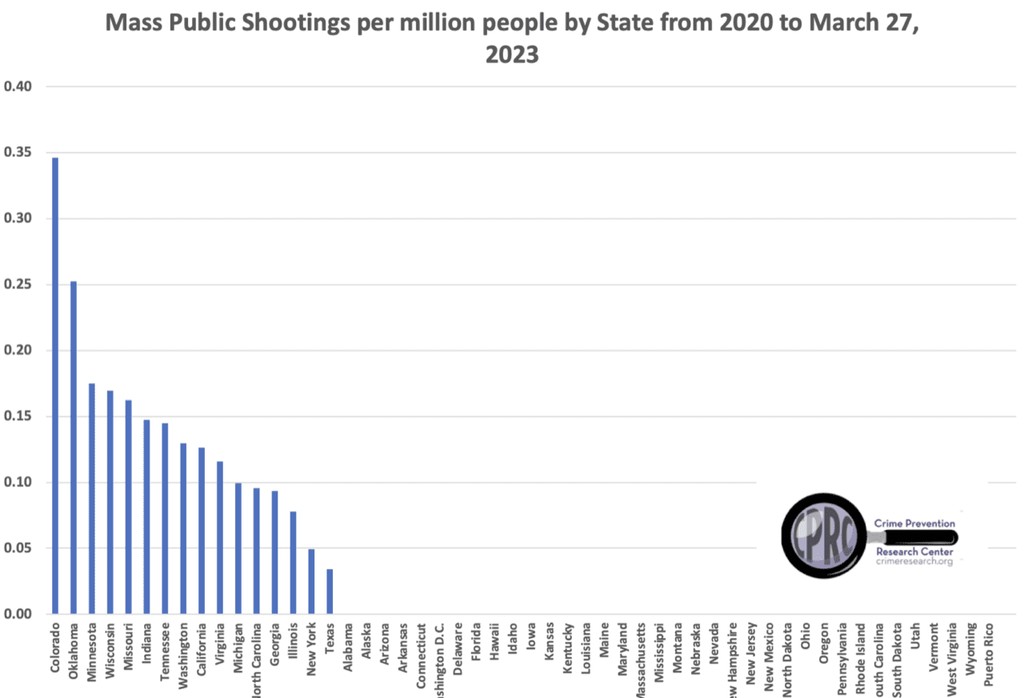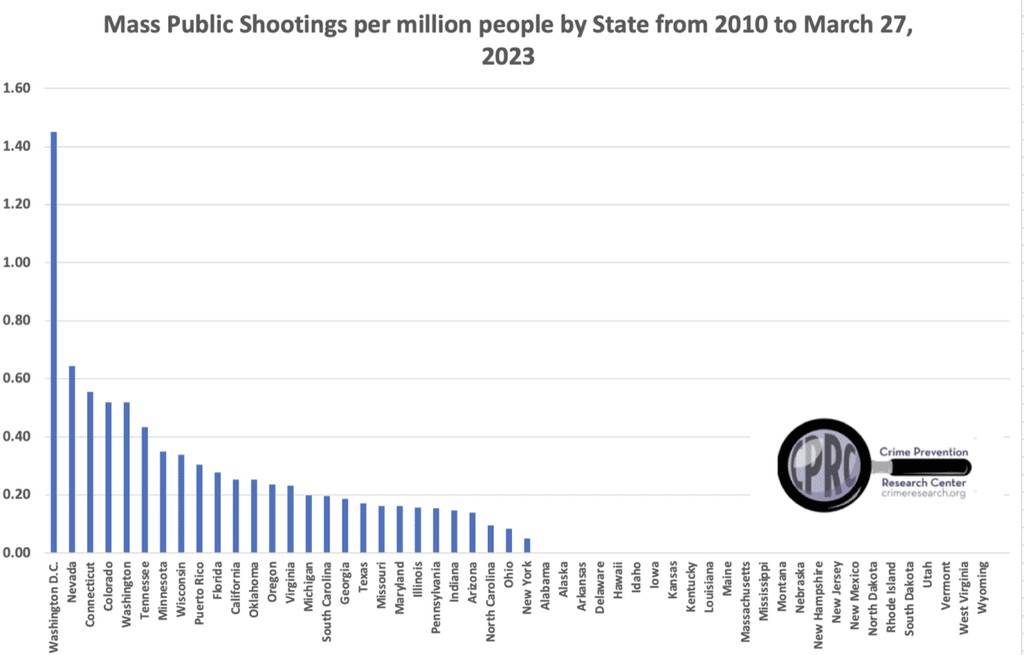A recent CNN article titled “Gun-loving Texas, where most households own a firearm, has become an epicenter of mass shootings” attempts to throw shade on the relationship between gun ownership rates in Texas and the incidence of mass shootings. Here, we’re going to set things straight and show why Reporter Emma Tucker and her editors at CNN claim correlation, imply causation, but end up missing their mark entirely. Which begs the question, is this another case of lazy journalism with an agenda?
Let’s start with CNN’s set-up, which immediately lays the blame for mass shootings on the “sheer number of guns” lawfully owned by Texans.
Five of the 10 deadliest mass shootings in America over the past eight years have been in Texas, the latest occurring in Allen in early May when a gunman fired an AR-15-style rifle at a crowded outlet mall, killing eight people and injuring at least seven others.
The number of mass shootings in Texas is no coincidence given the sheer number of guns in the hands of the public, several gun violence experts told CNN.
Texas has among the most expansive gun rights in the country – roughly 60% of households own at least one gun, according to an Everytown for Gun Safety analysis of 2021 data from the Centers for Disease Control and Prevention. That’s the second-highest rate in the country and above the national average of 55% of households owning one or more guns, according to Everytown.
While the topic is timely, the article falls short in various areas, including biased language, lack of context and comparative analysis, cherry-picked data, failure to engage with counterarguments, and a reliance on biased research from gun control groups. Certainly a more comprehensive and balanced approach is necessary when discussing such an important civil right as the one enshrined by the Second Amendment.
Let’s highlight several weaknesses and biases present in the article’s “analysis”, presentation, and call out the lack of journalistic integrity.
- Biased Language and Assumptions: Right from the outset, the article employs biased language and assumptions that undermine its objectivity. The use of phrases such as “gun-obsessed culture” and “lax gun laws” creates a negative portrayal of Texas gun owners and legislation. Such loaded language fails to provide a balanced perspective and indicates a predisposition to favor stricter gun control measures. Although the definition of mass shooting is called out in the article, it serves to confuse the definition of mass shooting in the minds of the reader. Most of us think of mass shootings as a targeted attack where the perpetrator and victims have no relationship. A random act of violence with great loss of life. That definition works for most incidents, with the possible exception of incidents of workplace violence. The definition used by CNN comes from the Gun Violence Archive, which defines a mass shooting as, “as a shooting that injures or kills four or more people, not including the shooter.” This definition often includes incidents that the average person would not identify as a mass shooting, such as a gang or drug related shooting or domestic violence.
- Lack of Context and Comparative Analysis: The article lacks crucial context and fails to engage in a comprehensive comparative analysis. It narrowly focuses on Texas, suggesting a direct correlation between high gun ownership rates and mass shootings. However, it conveniently overlooks important factors such as population density, socioeconomic conditions, and the presence of other contributing factors in these incidents. Without considering these variables, it becomes impossible to draw meaningful conclusions about the relationship between gun ownership and mass shootings.
- Cherry-Picked Data and Statistical Manipulation: The article selectively presents data that support its preconceived narrative while neglecting other relevant information. By highlighting specific incidents and anecdotes without providing a broader statistical analysis, the article reinforces confirmation bias and fails to present a comprehensive picture of the situation. Such cherry-picking of data undermines the article’s credibility and weakens its argument. Rather than do any independent analysis, the author cites as authoritative, research from Everytown and The Trace, even going as far as to call the latter an “independent news operation”.
- Ignoring Counterarguments: A responsible and balanced analysis should engage with counterarguments and alternative perspectives. However, the article largely ignores any arguments in favor of gun ownership, failing to present a fair and comprehensive assessment of the issue. By omitting crucial critical viewpoints, the article not only lacks intellectual rigor but also perpetuates a one-sided narrative.
- Lack of Needed Expert Opinions: The author relies almost entirely on opinions shared gun control groups and data by public health researchers, who lack expertise in criminology and often don’t understand factors like endogeniety in their research into gun violence. Input from experts in the field of criminology, could provide valuable insights into the complex factors contributing to mass shootings. There is zero acknowledgment of countervailing research showing the lack of correlation of gun ownership to crime. By excluding these perspectives, the article misses an opportunity to provide readers with a deeper understanding of the issue and undermines its credibility as an authoritative source of information.
Bearing Arms spoke with Kostas Moros, a civil rights attorney with Michel & Associates, which represents the California Rifle & Pistol Association. California has had a recent spate of mass shootings despite having some of the strictest gun control laws on the books. We asked Mr. Moros to review the CNN article and share his thoughts.
While it is true that Texas has had a bad run lately when it comes to mass shootings, several pro gun states with similar gun laws have not had any major mass shootings. It is a bad faith tactic by the media to focus in on one large population pro gun state while ignoring nearly all the others that have had no major mass shootings this year.
And the events of recent weeks prove this isn’t just tied to guns, as the day after the recent mass shooting in Texas that claimed the lives of 8 people, a deranged individual, also in Texas, used his car to kill the exact same amount of people.
As the article notes, the worst mass shooting so far this year has been in California, which has very strict gun laws. California has already had two public mass shootings this year, with 11 and 7 fatalities respectively.
Mr. Moros has a point. The article ignores other pro gun states where mass shootings are not as prevalent.
According to research from the Crime Prevention Research Center, California exceeds Texas in both mass shootings per million residents since 2020.

And California is ahead of Texas even going back to 2010.

While the CNN article acknowledges the mass shootings in California, it ignores the fact that many of the solutions called for in the article are already in place in California, none of which have not stopped recent shootings in the Golden State.
The deadliest US shooting this year, however, took place in California – a state that advocacy groups say has some of the strictest gun laws in the country – in Monterey Park, when 11 people were killed and nine injured at a Lunar New Year celebration in January.
Ms. Tucker then takes aim at those that claim mental health may be a contributing cause of the increased violence. Here she completely and deliberately misses the point. Claiming there is no link between mental health and mass shootings, nevertheless taking a shot at Gov. Abbot, and by implication all Republicans, for underfunding mental health services. If mental health plays no role, then why call out Gov. Abbott?
Where Ms. Tucker misleads her readers is by conflating a confirmed mental health diagnosis, a diagnosable psychopathology, with a genuine mental health crisis albeit undiagnosed. We know from extensive research by the U.S. Secret Service, that between almost half (46%) and two-thirds (67%) of the perpetrators of mass attacks they studied experienced psychotic symptoms, including hallucinations, paranoia, and delusions, depression or suicidal thoughts. While the Secret Service cautions about the causal relationship between mental health and mass shootings, understanding mental health factors is important, regardless of whether they have sought treatment or had a formal diagnosis. The Secret Service research says,
According to estimates from the Centers for Disease Control and Prevention (CDC), over half of the population in the United States will be diagnosed with a mental health disorder at some point in their lifetime, with 20% of adults experiencing mental health symptoms each year. 13 Of the 37 attackers in this study, at least 17 (46%) experienced mental health symptoms prior to their attacks.
The most common symptoms experienced by the attackers in 2019 were psychotic symptoms (n = 11, 30%), including hallucinations, paranoia, and delusions. The next most common symptom was depression, which was exhibited by one quarter of the attackers (n = 9, 24%). Five attackers (14%) had a history of suicidal thoughts. Some attackers experienced multiple types of mental health symptoms. For example, one attacker experienced paranoid delusions and also experienced symptoms of depression, suicidal thoughts, and aggression. While the percentage of attackers who experienced any mental health issue in 2019 (46%) was lower than the percentages from 2017 (64%) and 2018 (67%), the percentage of attackers who experienced psychotic symptoms, specifically, was about the same in each year. A third of the attackers (n = 11, 30%) in this study experienced these symptoms.
So why dismiss mental health as an issue? Well, gun control activists know that most “gun deaths” they cite are suicide related. They also know that if mental health is addressed by federal, state & local officials, the number of “gun deaths” would drop by over half and they’d have to rethink their entire approach to convincing the public that the only solution to gun violence is to force law abiding gun owners to give up their firearms.
Departing from the subject of mental health, Ms. Tucker does her very best to ignore the second leading factor in “gun deaths”, gang and drug related violence in blue cities. But that’s a topic for another day. And why not include commentary from CNN contributor Stephen Gutowski, a fantastic resource and part of the CNN team. Laziness or bias?
As expected, the CNN article on Texas gun ownership and mass shootings falls short of the journalistic standards we deserve and need as a functioning republic. By including biased language, lack of context and comparative analysis, cherry-picked data, failure to engage with counterarguments, and absence of needed expert opinions, one wonders if this was written by gun control activists and offered to CNN for publication. A more comprehensive and balanced approach is necessary when discussing issues of such national importance. Shame on CNN.








